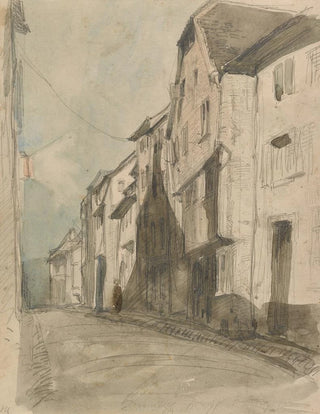Art print | Saverne - James Abbott McNeill Whistler


View from behind

Frame (optional)
Saverne Art print - James Abbott McNeill Whistler – Captivating Introduction
In the world of art, some works transcend their era to become timeless icons. "Saverne - James Abbott McNeill Whistler" is one of those creations that, through its delicacy and depth, transports us into a universe where light and shadow dance in harmony. This painting, evoking an atmosphere that is both peaceful and melancholic, invites us to explore the nuances of human perception through the lens of nature and urbanity. The artist, capturing not only a place but also an emotion, offers us a window into his inner world—a world where every brushstroke tells a story.
Style and uniqueness of the work
Whistler's style is often characterized by an impressionistic delicacy, where colors blend subtly to create an ethereal atmosphere. In "Saverne," the artist uses a palette of soft hues that evoke twilight, a transitional moment often symbolizing the passage of time. The blurred shapes and vague contours leave room for imagination, allowing the viewer to project their own feelings and memories onto the canvas. This art print does not merely depict a landscape; it captures the very essence of a fleeting moment, a suspended instant between reality and dream. The way Whistler plays with light and shadow, creating subtle reflections on the water and gentle shadows on the ground, demonstrates his exceptional talent and technical mastery.
The artist and his influence
James Abbott McNeill Whistler, an iconic figure of the 19th-century art movement, managed to leave his mark on his era with his innovative vision. Influenced by Japonism and Impressionist techniques, he developed a unique style that is entirely his own. Whistler did not merely reproduce reality; he sought to express emotions through his works, which allowed him to stand out from his contemporaries. His bold approach to composition and color paved the way for many artists who followed in his footsteps. By exploring themes such as ephemeral beauty and the harmony of forms, he contributed to redefining what

Matte finish

View from behind

Frame (optional)
Saverne Art print - James Abbott McNeill Whistler – Captivating Introduction
In the world of art, some works transcend their era to become timeless icons. "Saverne - James Abbott McNeill Whistler" is one of those creations that, through its delicacy and depth, transports us into a universe where light and shadow dance in harmony. This painting, evoking an atmosphere that is both peaceful and melancholic, invites us to explore the nuances of human perception through the lens of nature and urbanity. The artist, capturing not only a place but also an emotion, offers us a window into his inner world—a world where every brushstroke tells a story.
Style and uniqueness of the work
Whistler's style is often characterized by an impressionistic delicacy, where colors blend subtly to create an ethereal atmosphere. In "Saverne," the artist uses a palette of soft hues that evoke twilight, a transitional moment often symbolizing the passage of time. The blurred shapes and vague contours leave room for imagination, allowing the viewer to project their own feelings and memories onto the canvas. This art print does not merely depict a landscape; it captures the very essence of a fleeting moment, a suspended instant between reality and dream. The way Whistler plays with light and shadow, creating subtle reflections on the water and gentle shadows on the ground, demonstrates his exceptional talent and technical mastery.
The artist and his influence
James Abbott McNeill Whistler, an iconic figure of the 19th-century art movement, managed to leave his mark on his era with his innovative vision. Influenced by Japonism and Impressionist techniques, he developed a unique style that is entirely his own. Whistler did not merely reproduce reality; he sought to express emotions through his works, which allowed him to stand out from his contemporaries. His bold approach to composition and color paved the way for many artists who followed in his footsteps. By exploring themes such as ephemeral beauty and the harmony of forms, he contributed to redefining what






